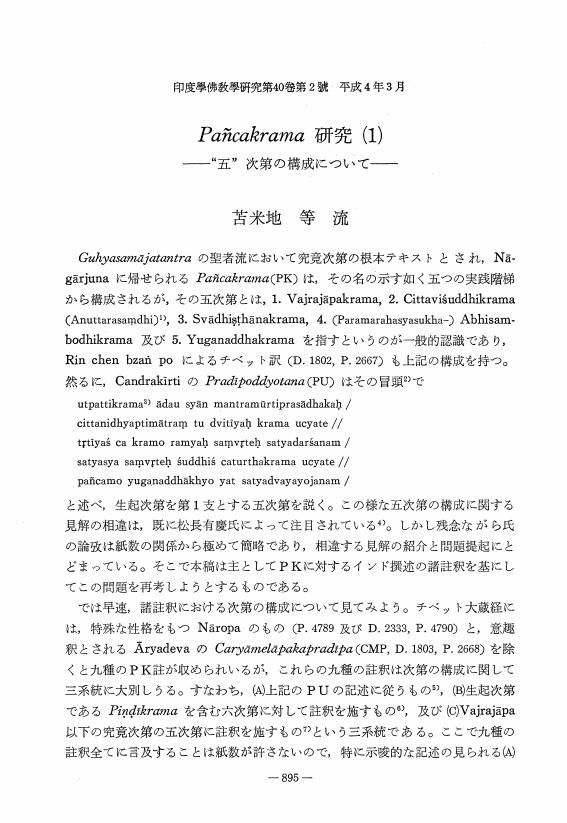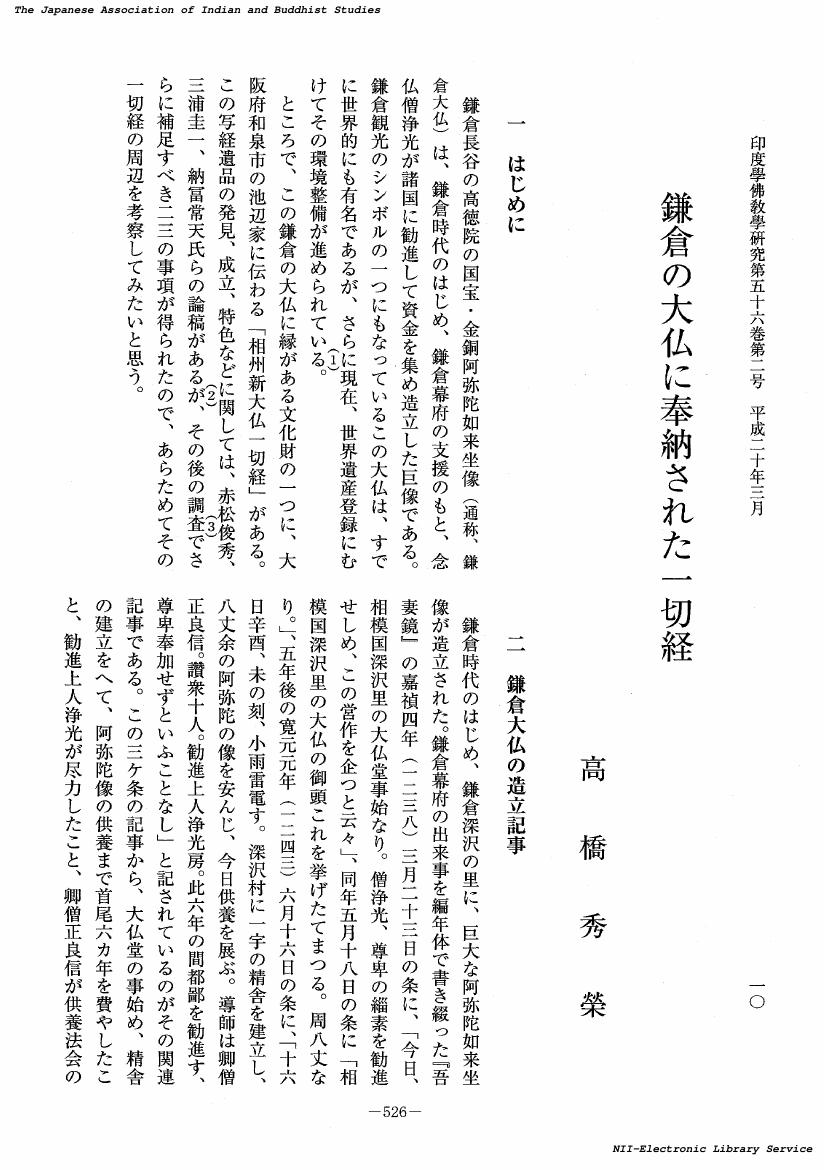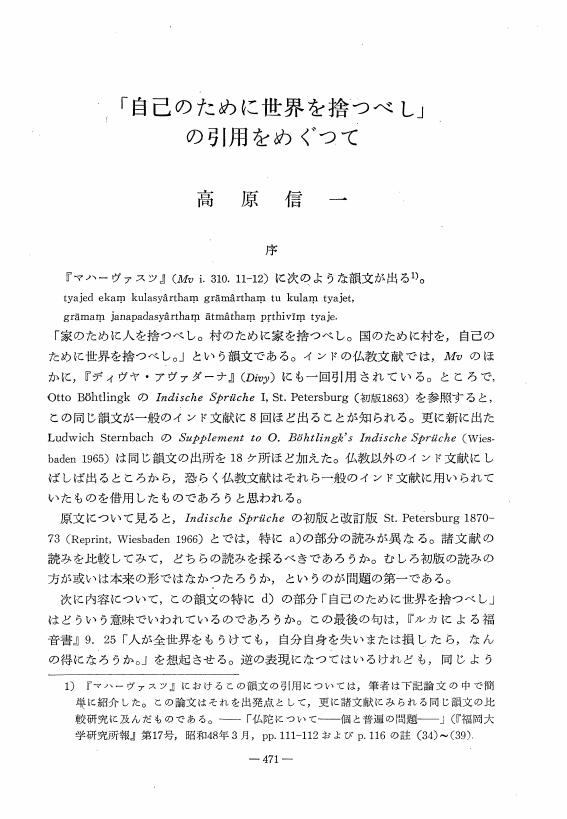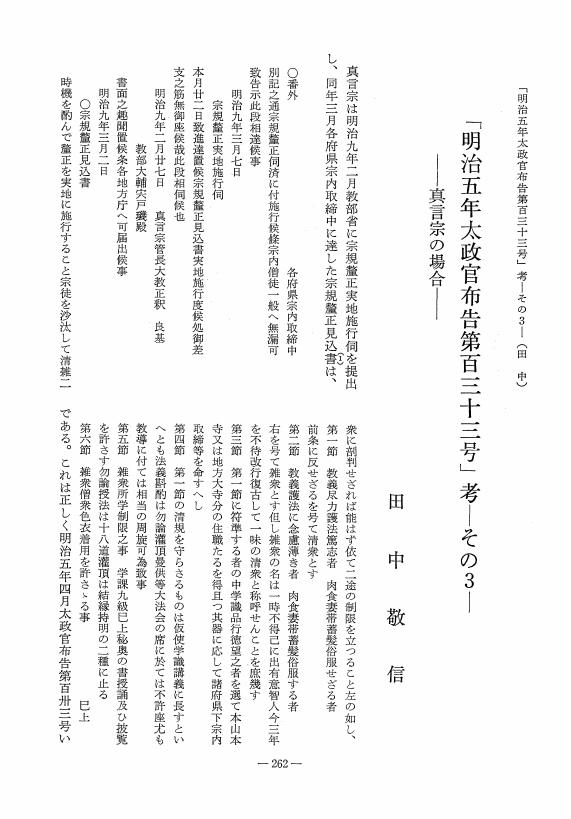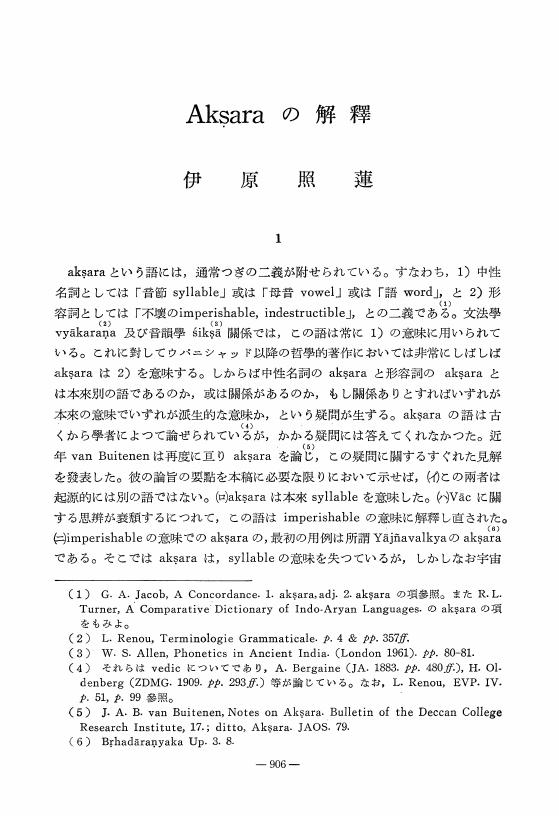1 0 0 0 OA 南泉と趙州
- 著者
- 平野 宗浄
- 出版者
- Japanese Association of Indian and Buddhist Studies
- 雑誌
- 印度學佛教學研究 (ISSN:00194344)
- 巻号頁・発行日
- vol.20, no.1, pp.273-276, 1971-12-31 (Released:2010-03-09)
1 0 0 0 OA Putrākhyā Daśa Pañca Ca
- 著者
- 谷口 力光
- 出版者
- 日本印度学仏教学会
- 雑誌
- 印度學佛教學研究 (ISSN:00194344)
- 巻号頁・発行日
- vol.71, no.3, pp.943-947, 2023-03-25 (Released:2023-09-08)
- 参考文献数
- 8
家産分割,相続の主体となる様々な「息子」は12世紀頃以降においていかにカテゴライズされ,相対的に位置づけられたか.本報告は,Vijñāneśvara著Mitākṣarā(ca. 1056-1126),Haradattamiśra著Ujjvalā(ca. 1100-1300)という2作品のdharmanibandhaが伝える息子論(eg., putraprakaraṇa)から,このような議論が精緻化してゆく様相の一端を跡付ける. putraprakaraṇaは,主要な息子とされる嫡出子(aurasa)と,養子(dattaka)や再婚女性の息子(paunarbhava)などとの相続上の関係性について情報を伝える.中世サンスクリット法律学における法益論や近現代南アジアにおける寡婦再婚問題などにも関連する重要主題の一つである. 主たる初期文献群(dharmasūtra, dharmaśāstra)は,微妙な相違はあるものの,一般に息子として12-13種類を数える.しかし,その数はMitākṣarāでは14種類,さらにUjjvalāでは15種類に至る.既往研究では,このような息子に関する議論について,諸資料に見られる相違点は「なにか」という点での貢献が行われてきた.本稿は,それらの相違点が「どのように」生じるのかに焦点を当てる. 具体的には,Mitākṣarā,Ujjvalāに見られる発達した議論の間にある唯一の相違点である “yatra kvacanotpādita”と呼ばれる息子種について,これがなぜ前者では言及されず,後者では第15位の息子として掲げられるようになったのかについて,その学的背景を探る.そして,これら両資料が想定していたであろう「結婚の正当性」との関係から,この差異を説明可能であることなどを指摘する. 南アジア広域で指導的地歩を築いたMitākṣarāと,最多の息子種を数えるらしいUjjvalāとの差異化の一端が示されることで,それ以降に著されたdharmanibandhaなどとの比較を行う上での基盤が得られたと期待する.
1 0 0 0 OA 最高のヨーガ
- 著者
- 遠藤 康
- 出版者
- Japanese Association of Indian and Buddhist Studies
- 雑誌
- 印度學佛教學研究 (ISSN:00194344)
- 巻号頁・発行日
- vol.43, no.2, pp.963-956, 1995-03-25 (Released:2010-03-09)
- 参考文献数
- 20
- 被引用文献数
- 1 1
1 0 0 0 OA 陰陽道祭文と修験道祭文 -牛頭天王祭文を例として-
- 著者
- 岩佐 貫三
- 出版者
- Japanese Association of Indian and Buddhist Studies
- 雑誌
- 印度學佛教學研究 (ISSN:00194344)
- 巻号頁・発行日
- vol.23, no.1, pp.317-321, 1974-12-25 (Released:2010-03-09)
1 0 0 0 OA 近代日蓮宗における「充洽園教学」の意義
- 著者
- 小野 文〓
- 出版者
- Japanese Association of Indian and Buddhist Studies
- 雑誌
- 印度學佛教學研究 (ISSN:00194344)
- 巻号頁・発行日
- vol.35, no.1, pp.233-238, 1986-12-25 (Released:2010-03-09)
1 0 0 0 OA 島地黙雷の神道観
- 著者
- 野世 英水
- 出版者
- Japanese Association of Indian and Buddhist Studies
- 雑誌
- 印度學佛教學研究 (ISSN:00194344)
- 巻号頁・発行日
- vol.43, no.1, pp.184-188, 1994-12-20 (Released:2010-03-09)
1 0 0 0 OA 最澄の小戒棄捨について
- 著者
- 蓑輪 顕量
- 出版者
- Japanese Association of Indian and Buddhist Studies
- 雑誌
- 印度學佛教學研究 (ISSN:00194344)
- 巻号頁・発行日
- vol.36, no.1, pp.127-130, 1987-12-25 (Released:2010-03-09)
1 0 0 0 OA Pañcakrama 研究 (1)
- 著者
- 苫米地 等流
- 出版者
- Japanese Association of Indian and Buddhist Studies
- 雑誌
- 印度學佛教學研究 (ISSN:00194344)
- 巻号頁・発行日
- vol.40, no.2, pp.895-892, 1992-03-20 (Released:2010-03-09)
1 0 0 0 OA 四天の邪鬼と方相鬼 -鬼の思想研究・その三-
- 著者
- 岩佐 貫三
- 出版者
- Japanese Association of Indian and Buddhist Studies
- 雑誌
- 印度學佛教學研究 (ISSN:00194344)
- 巻号頁・発行日
- vol.25, no.1, pp.387-390, 1976-12-25 (Released:2010-03-09)
1 0 0 0 OA 法天訳『最上大乘金剛大教寶王經』と『秘密集会タントラ』聖者流
- 著者
- 苫米地 等流
- 出版者
- 日本印度学仏教学会
- 雑誌
- 印度學佛教學研究 (ISSN:00194344)
- 巻号頁・発行日
- vol.61, no.1, pp.406-401, 2012-12-20 (Released:2017-09-01)
1 0 0 0 OA 中世曹洞宗と霊山信仰
- 著者
- 石川 力山
- 出版者
- Japanese Association of Indian and Buddhist Studies
- 雑誌
- 印度學佛教學研究 (ISSN:00194344)
- 巻号頁・発行日
- vol.33, no.2, pp.441-446, 1985-03-25 (Released:2010-03-09)
1 0 0 0 OA 中世曹洞宗の地方展開と源翁心昭
- 著者
- 石川 力山
- 出版者
- Japanese Association of Indian and Buddhist Studies
- 雑誌
- 印度學佛教學研究 (ISSN:00194344)
- 巻号頁・発行日
- vol.31, no.1, pp.227-231, 1982-12-25 (Released:2010-03-09)
1 0 0 0 OA 偽作の法句経と疏の異本について
- 著者
- 田中 良昭
- 出版者
- Japanese Association of Indian and Buddhist Studies
- 雑誌
- 印度學佛教學研究 (ISSN:00194344)
- 巻号頁・発行日
- vol.23, no.1, pp.122-129, 1974-12-25 (Released:2010-03-09)
1 0 0 0 OA 鎌倉の大仏に奉納された一切経
- 著者
- 高橋 秀榮
- 出版者
- 日本印度学仏教学会
- 雑誌
- 印度學佛教學研究 (ISSN:00194344)
- 巻号頁・発行日
- vol.56, no.2, pp.526-533, 2008-03-20 (Released:2017-09-01)
1 0 0 0 OA ソービタ長老釈仁度和上招来の貝多羅葉について
- 著者
- 東元 慶喜
- 出版者
- Japanese Association of Indian and Buddhist Studies
- 雑誌
- 印度學佛教學研究 (ISSN:00194344)
- 巻号頁・発行日
- vol.31, no.2, pp.486-492, 1983-03-25 (Released:2010-03-09)
1 0 0 0 OA 「自己のために世界を捨つべし」の引用をめぐって
- 著者
- 高原 信一
- 出版者
- Japanese Association of Indian and Buddhist Studies
- 雑誌
- 印度學佛教學研究 (ISSN:00194344)
- 巻号頁・発行日
- vol.22, no.1, pp.471-461, 1973-12-31 (Released:2010-03-09)
1 0 0 0 OA 広蔵院日辰の先師批判について
- 著者
- 田村 完爾
- 出版者
- Japanese Association of Indian and Buddhist Studies
- 雑誌
- 印度學佛教學研究 (ISSN:00194344)
- 巻号頁・発行日
- vol.45, no.1, pp.237-239, 1996-12-20 (Released:2010-03-09)
1 0 0 0 OA 「明治五年太政官布告第百三十三号」考 -その3- -真言宗の場合-
- 著者
- 田中 敬信
- 出版者
- Japanese Association of Indian and Buddhist Studies
- 雑誌
- 印度學佛教學研究 (ISSN:00194344)
- 巻号頁・発行日
- vol.33, no.1, pp.262-265, 1984-12-25 (Released:2010-03-09)
1 0 0 0 OA 広蔵院日辰の本迹論に関する一考察――序品題号の「妙法」をめぐって――
- 著者
- 神田 大輝
- 出版者
- 日本印度学仏教学会
- 雑誌
- 印度學佛教學研究 (ISSN:00194344)
- 巻号頁・発行日
- vol.68, no.2, pp.670-675, 2020-03-20 (Released:2020-09-10)
- 参考文献数
- 3
In relation to the various religious doctrines which became diversified after the death of Nichiren (日蓮), the viewpoint of Honjaku theory (本迹論) is the most important index to examine the characteristics of the disciples. Kōzōin Nisshin (広蔵院日辰, mid-16th c.), who was based in Kyoto during the Sengoku Period, was a notable learned priest who established a major theoretical system of the Honjaku theory. Nisshin discriminated between Honmon (本門) and Shakumon (迹門). The distinctive feature of the theory is that it discusses the superiority of “Chapter 16, Nyorai Juryō-hon (如来寿量品第十六)” out of the 28 chapters of the Lotus Sūtra. In this paper, in order to clarify the characteristics of the Honjaku theory of Nisshin, I compare it with the theory of the Icchi school (一致派) priests who discussed the unity of the Honmon and Shakumon. I took up as my starting point the contention shared by the learned priests of the Shoretsu (勝劣) and Icchi schools, that is, the interpretation of “Myōhō 妙法” in the first introductory chapter. The teachings of the abovementioned priests strongly reflect the characteristics of the doctrines that they upheld. Here I point out that Nisshin interprets this “Myōhō” of the title of the introductory chapter based on the sixteenth chapter.
1 0 0 0 OA Aksara の解釋
- 著者
- 伊原 照蓮
- 出版者
- Japanese Association of Indian and Buddhist Studies
- 雑誌
- 印度學佛教學研究 (ISSN:00194344)
- 巻号頁・発行日
- vol.15, no.2, pp.906-901, 1967-03-31 (Released:2010-03-09)






